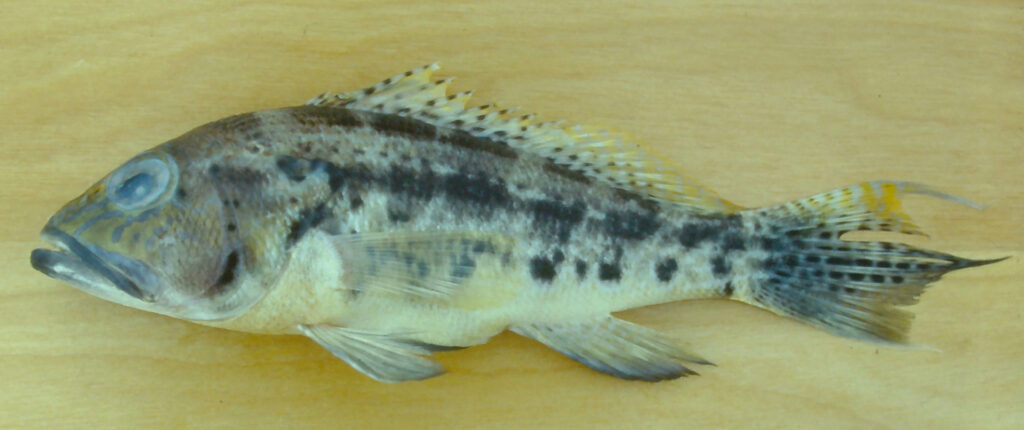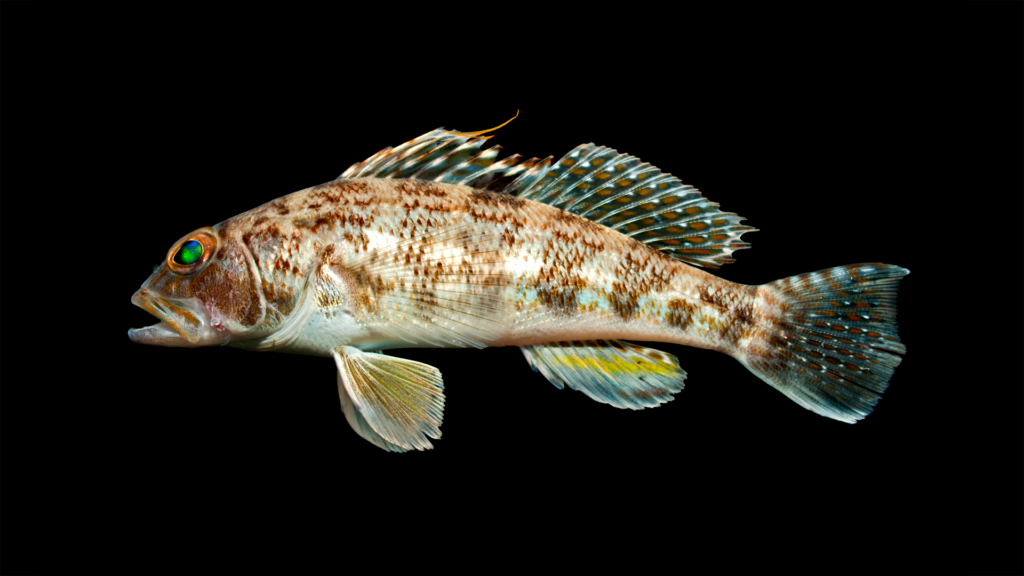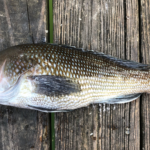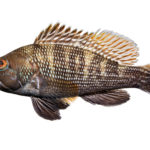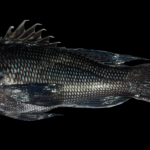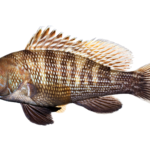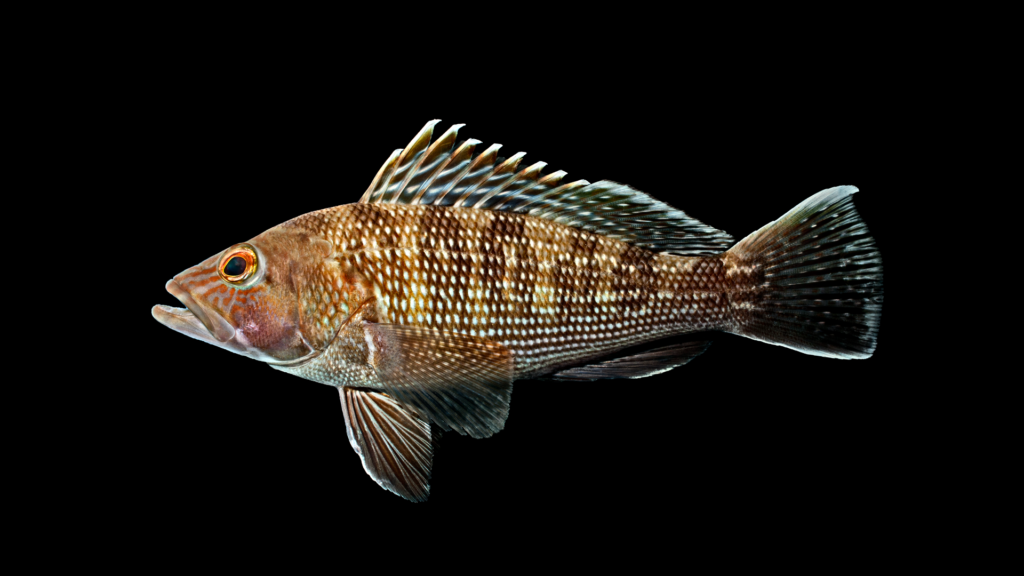
| Family | Scientific Name | Author | Year | Common Name |
| Serranidae | Centropristis striata | (Linnaeus) | 1758 | Black Sea Bass |
All Centropristis (except C. fuscula)– Dorsal fin with 10 spines and 10-12 rays. Anal fin with 3 spines and 6-13 rays. Most of upper edge of operculum free, not connected by skin to body. Caudal fin of adults sinuous or trilobed, the upper, middle, and lower rays elongated. Head larger, its length contained 2.3-3.3 times in standard length. Preopercle without a large antrorse spine; middle opercle spine not reaching edge of operculum. Front nostrils variously shaped, but always closer to rear nostrils than to upper lip. Supramaxilla absent. Teeth fixed (not depressible). No scaly flap of skin joining upper part of pectoral-fin base to body. Soft dorsal and anal fins mostly naked (hence the rays are easy to count). Scales larger, the lateral scale series about the same number (39-55) as the lateral-line scales. Preopercle not expanded posteriorly, the serrae at the angle only slightly enlarged. Upper jaw moderately protrusile; jaw teeth distinct; vomer and palatines with teeth. Body depth 27-48% standard length. Posterior process of premaxilla broad and near tip of alveolar ramus. Scales 31-64 in lateral line. Total gill rakers 14-31. Branched caudal-fin rays 13-15. Interspinous dorsal-fin membranes forming a short filament at tips of most spines. Pectoral-fin rays 16-20. Lateral-line scales 46-49.
Centropristis striata
Unique Characters: Caudal fin of adults sinuous or trilobed, the uppermost, middle, and lowermost rays elongated. Juveniles with rounded caudal fin. Dorsal-fin with short filaments at tips of spines; dorsal-fin rays 11 (rarely 10 or 12). Caudal-fin branched rays 15. Total gill rakers on first arch (including rudiments) 21-29. Adults dark, with a pale spot on each scale, forming longitudinal series of silvery spots, Dorsal-fin spines silvery blue, the membranes black, with silvery streaks and spots. Irregular pale blotches often visible on dorsal part of body. Juveniles mottled with brown blotches and small white spots, a dark brown or black midlateral band from eye to base of caudal fin; large black spot at base of last 3 dorsal spines; turquoise horizontal streaks on lower part of head.
Similar Species:
Bank Sea Bass
Centropristis ocyurus
Rock Sea Bass
Centropristis philadelphica
Bank Sea Bass Centropristis ocyurus. Caudal fin of adults sinuous or trilobed, the uppermost, middle, and lowermost rays elongated. Juveniles with rounded caudal fin. Dorsal-fin with short filaments at tips of spines; dorsal-fin rays 11 (rarely 10 or 12). Caudal-fin branched rays 15. Total gill rakers on first arch (including rudiments) 17-22. Body pale, with 7 more or less distinct, dark vertical bars. Dorsal and caudal fins pale, with several dark spots and a few smaller white spots. Dorsal spines with short filaments rarely extending past spine tips. No large black spot at base of last 3 dorsal-fin spines. Dark bars on body blackish brown and distinct, the lower third of bars often separated as a longitudinal series of black blotches. Dorsal and caudal fins with small black spots. Adult with violet streaks on front of head, upper jaw and lip. Interorbital width 6-9% standard length.
Rock Sea Bass Centropristis philadelphica. Caudal fin of adults sinuous or trilobed, the uppermost, middle, and lowermost rays elongated. Juveniles with rounded caudal fin. Dorsal-fin with short filaments at tips of spines; dorsal-fin rays 11 (rarely 10 or 12). Caudal-fin branched rays 15. Total gill rakers on first arch (including rudiments) 17-22. Body pale, with 7 more or less distinct, dark vertical bars. Dorsal and caudal fins pale, with several dark spots and a few smaller white spots. Dorsal fin filaments often extending past spine tips. A large black spot at base of last 3 dorsal-fin spines. Dark bars on body brownish, not well defined. Dark spots on dorsal and caudal fins reddish brown or golden brown. Interorbital width 4-6% standard length.
Twospot Sea Bass
Centropristis fuscula
Twospot Sea Bass Centropristis fuscula. Dorsal fin with 10 spines and 10-14 rays. Anal fin with 3 spines and 6-13 rays. Most of upper edge of operculum free, not connected by skin to body. Caudal fin of adults truncate or emarginate. Head larger, its length contained 2.3-3.3 times in standard length. Preopercle without a large antrorse spine; middle opercle spine not reaching edge of operculum. Front nostrils variously shaped, but always closer to rear nostrils than to upper lip. Supramaxilla absent. Teeth fixed (not depressible). No scaly flap of skin joining upper part of pectoral-fin base to body. Soft dorsal and anal fins mostly naked (hence the rays are easy to count). Scales larger, the lateral scale series about the same number (39-55) as the lateral-line scales. Preopercle not expanded posteriorly, the serrae at the angle only slightly enlarged. Upper jaw moderately protrusile; jaw teeth distinct; vomer and palatines with teeth. Body depth 27-48% standard length. Posterior process of premaxilla broad and near tip of alveolar ramus. Scales 31-64 in lateral line. Total gill rakers 14-31. Branched caudal-fin rays 13-15. No obvious filaments at tips of dorsal-fin spines. Pectoral-fin rays 13-18. Lateral-line scales 39-63. Pectoral-fin rays 18. Caudal-fin branched rays 7+6. Dark oval spot at caudal-fin base and large dark blotch on first 2 rows of scales below lateral line at middle of body.
Gallery
